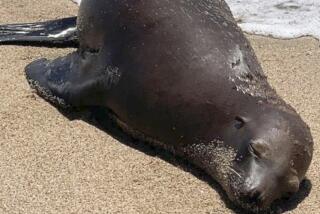8 sea lions die from algae-produced toxin off Orange County, marine mammal center says
A toxin produced by algal blooms in the Pacific Ocean is the suspected culprit in multiple sea lion deaths, an official with Laguna Beach’s Pacific Marine Mammal Center said.
Since April 4, the center that cares for marine mammals stranded from Seal Beach south to San Onofre has rescued 15 sea lions poisoned by domoic acid, public relations coordinator Krysta Higuchi said Thursday. Eight of the animals have died.
“Unfortunately, when an animal is that far along, there is not much we can do,” Higuchi said. “We have not seen something like this since 2007.”
Higuchi said she went to Main Beach in Laguna Beach on April 4 after receiving reports of a sea lion that looked confused.
“It was sitting on the rocks and its head was weaving, which is one of the signs of domoic acid poisoning,” Higuchi said, adding that affected sea lions are non-responsive, lethargic and can suffer seizures.
The story first was reported by the Orange County Register.
For the other seven sea lions in the center’s care, Higuchi said staff were injecting the animals with intravenous fluids to “flush the toxins out” before it affected their brains.
Algae produce domoic acid, a neurotoxin, as a natural byproduct. The toxin targets the brain, specifically the hippocampus, according to the Pacific Marine Mammal Center website.
“The acid binds to receptors in neurons and inhibits nerve transmission,” said Peter Franks, professor of biological oceanography at the Scripps Institution of Oceanography at UC San Diego.
Sea lions and other marine mammals ingest the toxin when they eat fish such as sardines and anchovies.
Higuchi said pregnant adult females are most susceptible to domoic acid poisoning because they eat twice the normal amount as they await the birth of their pup.
Domoic acid can be harmful and fatal to humans as well.
Two years ago, elevated toxin levels led shellfish managers to close the southern Washington coast to Dungeness crab fishing, according to the National Oceanic and Atmospheric Administration Fisheries Northwest Fisheries Science Center website.
Most strandings of sea lions affected with domoic acid have occurred in Los Angeles and Orange counties, but reports have been made from Santa Barbara south to San Diego, said Justin Viezbicke, California stranding network coordinator for NOAA Fisheries.
Alderton writes for Times Community News
More to Read
Sign up for Essential California
The most important California stories and recommendations in your inbox every morning.
You may occasionally receive promotional content from the Los Angeles Times.











